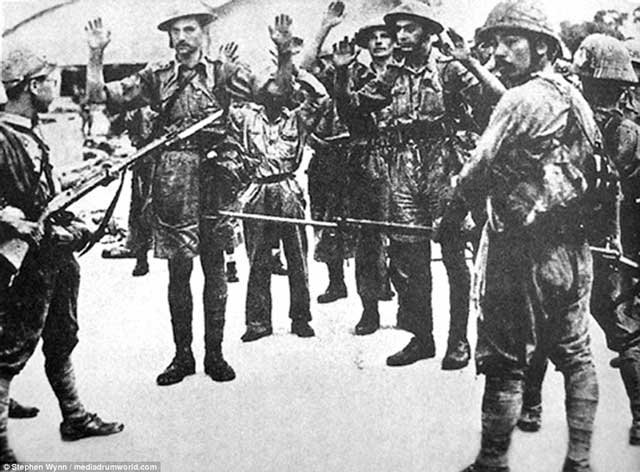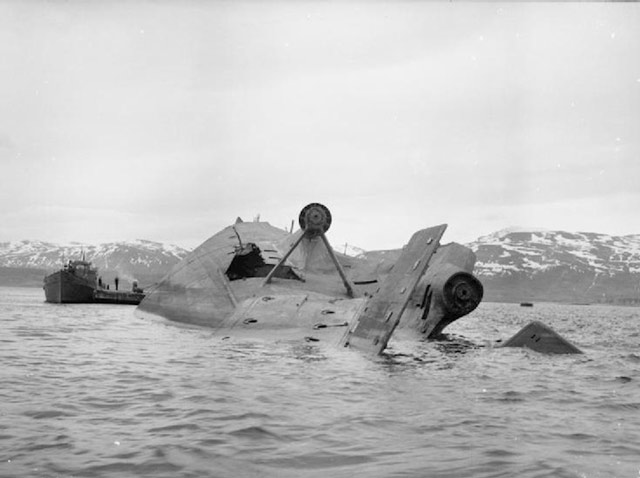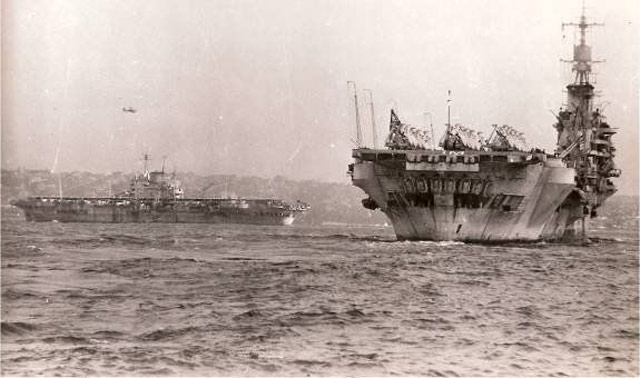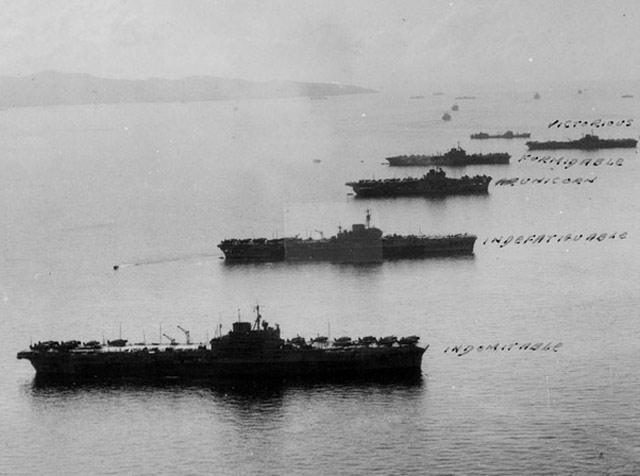In Search of Political Glory
 |
| Seafire IIIs of RAF Nos. 887 and 894 Squadron aboard HMS Indefatigable en route from Australia to New Zealand in November 1945. |
An enduring question about World War II is how much did the Royal Navy contribute to the defeat of Japan. Let's take a closer look and see what the Royal Navy did, and why.
United States control of the Pacific Theater of Operations (PTO) during World War II was a product of simple reality. The US Joint Chiefs of Staff acquired complete control of the PTO on 24 March 1942. This was part of a “grand bargain” made between President Roosevelt, who asked explicitly in a 9 March 1942 cable for US control of the PTO, and Prime Minister Winston Churchill. Roosevelt argued then that it was time to replace the "complexity" of the "obsolescent" command arrangements in the Pacific and give the United States military sole authority there, as the US already was planning "offensives in a northwesterly direction."
This "complexity" Roosevelt referred to apparently meant nominal British political control over Australia and New Zealand while the United States now conclusively had established military control. The political chain of command interfered with the de facto military one. In effect, Roosevelt asked for US military hegemony in the Pacific. Churchill, still reeling from the loss of Singapore, quickly agreed.
 |
| The fall of Singapore on 15 February 1942 was the major turning point in Royal Navy ambitions in the Pacific. It would not return in force until 1945. |
After Early Losses, the British largely Abandon the Pacific
Singapore was the cornerstone of British strength in the Pacific. Its loss in February 1942 ended the longstanding British power east of India for some time. The British Admiralty realized the dangers of reinforcing the Indian Ocean, much less the Pacific, following the loss of battleship Prince of Wales and cruiser Repulse off the Malayan Peninsula in December 1941. The Royal Navy was hard-pressed just protecting the North Atlantic convoys and maintaining a credible defensive presence in the British Isles themselves. Many Royal Navy warships were being repaired in US shipyards throughout 1942 and 1943 and the Admiralty did not have the ships to spare for presumably profitless expeditions to the Pacific. The Australians basically accepted their abandonment by the British when they accepted US General Douglas MacArthur as the supreme commander in the Southwest Pacific Theater of Operations on 17 March 1942.
The successful Japanese Indian Ocean Raid of early April 1942 that threatened British control of India was another eye-opener. Royal Navy weakness in the region became obvious when it was forced to move its Asian command (at that time basically just covering the Indian Ocean) all the way back to Kilindini, Kenya, the old East Africa Station, on 11 April 1942. There it remained under the command of Flag Officer, East Africa, Rear-Admiral A.D. Read and his successors until the Japanese threat to Ceylon (Sri Lanka) was considered ended. This showed that the British had their hands full just defending their bastion of strength in the Indian Ocean, much less operating in strength in the Pacific.
The Royal Navy Helps Out On Occasion
The US Navy was hard-pressed in the PTO throughout 1942 and 1943. US Chief of Naval Operations Admiral Ernest J. King always placed naval operations there as a priority and often requested Royal Navy assistance during this period (the first request, denied, was made immediately after the Battle of Midway in June 1942). The British, though, were loathe to dispatch ships from what they considered the all-important European Theater of Operations (ETO). Thus, the US Navy was left to carry the main burden in the PTO.
The Royal Navy did help out when it had the ships to spare and assistance could prove useful. After a refit at the Norfolk, Virginia, naval yard, the carrier HMS Victorious (R 38), for instance, sailed to the Pacific through the Panama Canal on 14 February 1943. Victorious was given the radio call-sign “Robin” as a security/ deception measure, though it never actually became the USS Robin and flew the British flag.
 |
| HMS Victorious flight direction room sometime during 1942. This was a strength of all Royal Navy carriers. |
Victorious served as part of the US Navy Third Fleet during much of the rest of 1943 as part of Carrier Division One. This was during a period when the US Navy was short of flight decks due to the loss of USS Hornet and damage to Enterprise in the Santa Cruz islands campaign. As part of Task Force 14 (later Task Group 36.3), Victorious covered the invasion of New Georgia during Operation Cartwheel and spent a record (for the Royal Navy) 28 consecutive days in combat operations at sea. Victorious was recalled in July when the first two new US Essex-class carriers arrived at Pearl Harbor ahead of schedule, ending the temporary US shortage of available flat tops.
There was no unanimity on either side about the use of Royal Navy forces in the PTO during 1942-1944. Admiral Sir Percy Noble, head of the British Admiralty Delegation in Washington, advocated strongly for an increased Royal Navy presence in the PTO as early as January 1944. He had no influence. There was no political will for transferring forces to the PTO as long as the German Kriegsmarine remained a credible threat. So, everyone waited for major developments in the North Atlantic, which were a long time in coming.
 |
| The sinking of the German battleship Tirpitz in November 1944 finally freed up Royal Navy forces for the Pacific. |
Sinking the Tirpitz Finally Frees Up Royal Navy Forces
British preoccupation with protecting the home islands remained the reality until the sinking of the German battleship Tirpitz on 12 November 1944 after ceaseless British attacks on it throughout the war years. This was the turning point regarding a Royal Navy presence in the Pacific. The Admiralty finally concluded at that time that the world naval situation had changed, the British Isles were no longer in jeopardy, and it was time to begin transferring units to the Pacific Theater. In my estimation, this decision was political as much as a military one, as the Churchill government would have fallen if the Tirpitz somehow, against all the odds, turned up off the coast of England and began shelling British civilians.
The British Pacific Fleet (BPF) was inaugurated soon thereafter on 22 November 1944 (before that, the few Royal Navy ships in the theater were in the old prewar “Eastern Fleet”). It is important to emphasize that it was a British decision to keep all of the large Royal Navy forces in the Atlantic and leave the PTO to the Americans, this was not a decision that was imposed upon them. The British would have simply abandoned the PTO without the large US presence there.
 |
| The crew of HMS Implacable of the BPF stowing an Avenger into the upper hangar in 1945 (Australian War Memorial No. 019034). |
It’s easy to think now that changes in things like naval fleets happen immediately or quickly. That was not the case during World War II (nor is it now, for that matter). The BPF took time to set up and its main base was at Sydney, with a forward base at Manus Island. This was considered quite adventurous, as more cautious minds in the Admiralty would have placed fleet headquarters all the way back in India.
There was an immediate misunderstanding with the Australian government over funding for the BPF and related issues. These may seem like pesky details, but they take time to sort out, especially while there’s a war on and leaders have other major decisions to make. Ultimately, the Royal Navy fleet did not even arrive in the PTO until 4 February 1945, and it was not at what would consider “full strength” until June. The US Navy was completely accommodating to the Royal Navy’s new presence in the theater and gave the BPF combat units the name Task Force 57 (TF-57) when they joined Admiral Raymond Spruance's United States Fifth Fleet on 15 March 1945.
 |
| HMS Formidable (as seen from Victorious) on fire after a Kamikaze hit off Sakishima Gunto on 4 May 1945. There were eight dead and 47 wounded, with eleven Allied aircraft destroyed (© IWM A 29717). |
The Royal Navy on the Attack in the Pacific
There was some reluctance on both sides over the commitment of major Royal Navy assets in the PTO even after the sinking of the Tirpitz. To sum up the general feeling, the British were torn between sacrificing even more men in a war they considered basically won and upholding their national honor by helping to beat Japan. The Americans, on the other hand, were suspicious of the Royal Navy's ability to help in the PTO and also a bit skeptical of British motivations in trying to horn in on claiming partial credit for the US Navy success there.
 |
| US Admiral Ernest J. King didn't get Royal Navy help when he wanted it but did when he no longer needed it. |
US Fleet Admiral (as of 19 December 1944) Chester Nimitz, for instance, questioned the ability of Royal Navy ships that had been designed for the relatively confined sphere of operations in the ETO to operate on long-range missions in the PTO. Royal Navy Rear Admiral Philip Vian (in his memoir "Action This Day") recalled:
Meanwhile, Admiral [Bruce] Fraser, appreciating fully the great importance, from a national point of view, of the Royal Navy engaging in the most modern type of sea warfare in company with the Americans who had perfected it, had been striving to convince Admiral Nimitz that the British would not only be able to operate alongside the Americans without calling on them for logistic aid, but that their Fleet would be of real help in the task which lay ahead – defeating Japan. He found that, like Admiral King, Admiral Nimitz felt that the fast United States carrier striking forces were perfectly capable of dealing, on their own, with the operations contemplated for the final reduction of the enemy…
Admiral King agreed with some British admirals that the Royal Navy was best occupied in the Indian Ocean attacking Japanese supply lines there. This hopefully, from his point of view, would provide a diversionary function and draw off some Japanese forces from the main axes of attack in the Pacific. This would make the conquest of Japan easier. It also would be less dangerous and offer less glory to the Royal Navy - or, more accurately again from King's perspective - was desirable because it would reserve all the glory for the US Navy.
Some read into King's position a degree of resentment over British refusals to help out earlier in the war. Vian himself, however, accepted that Admiral King's position was not rooted in anglophobia but instead what King considered best for the US Navy. There were varying degrees of national pride and resentment over unfair load-sharing during the war on both sides, of course, and justifications aplenty for every position depending on how minutely or globally one examined the issue.
Just to flesh it out a bit, the British rightfully (in their eyes) resented having to carry the full military load against Hitler for over two long years and deserved a share of any glory for that reason alone, while the Americans rightfully (in their eyes) felt they had won the war in the Pacific basically by themselves and deserved all of the credit there. Neither position was 100% accurate but each did carry a grain of truth. The British also wanted to be on the scene to legitimize and protect their post-war interests in colonies in Singapore, Hong Kong, and elsewhere. There no doubt were other petty resentments and grudges on both sides.
Apparently, King did more or less try to block the use of the BPF but was overruled by Roosevelt at Churchill's insistence. Due to Japan's weakness, this was a political matter more than a military one by this late point of the war.
 |
| In a politically motivated display of Royal Navy power, HMS Formidable leads the British Pacific Fleet into Sydney Harbor on 24 August 1945 after three months of operations off the coast of Japan. |
Churchill, who was the final arbiter of all major British strategic decisions during the war, himself revealed the real reason for a Royal Navy commitment to the PTO during its final days. In an address to Parliament on 28 September 1944, Churchill said:
The new phase of the war against Japan will command all our resources from the moment the German War is ended. We owe it to Australia and New Zealand to help them remove forever the Japanese menace to their homelands, and as they have helped us on every front in the fight against Germany we will not be behindhand in giving them effective aid.
In other words, the main impetus behind the Royal Navy's entry into the PTO was purely political. The British wanted to share in the victory over Japan one way or another. Ultimately, it became a matter of British national prestige (as Vian hints at in the selected passage above). The Royal Navy was committed to the PTO in strategic operations, not a mere ancillary role.
The BPF participated in attacks on Japanese forces throughout 1945. Naturally, the US Navy by that point had its equipment built up with landing craft and all the supply chains necessary for invasions, so the Royal Navy wasn’t about to start invading islands and planning its own campaigns and so forth. On the flip side, however, the armored flight decks of the Royal Navy carriers proved more impervious to Japanese Kamikaze attacks, though the attacks did cause long-term problems. The Royal Navy usually played a complementary role to the ongoing strike operations of the US Navy as that was its best way to contribute.
 |
| The pride of the British Pacific Fleet at anchor, as it spent much of its time during its brief tenure during World War II. |
The Royal Navy could have played a much more prominent role in the PTO if the war had lasted longer. By August 1945, the BPF (which included ships of Australia and New Zealand, but all the capital ships were British) had six fleet carriers available:
- Formidable: approximate air group of 36 Corsairs, 15 Avengers (Flagship 1st Aircraft Carrier Squadron)
- Illustrious: air group 36 Corsairs, 15 Avengers
- Implacable: 48 Seafire, 21 Avenger, 12 Firefly
- Indefatigable: 40 Seafire, 18 Avenger, 12 Firefly
- Indomitable: 39 Hellcats, 21 Avengers
- Victorious: 36 Corsairs, 15 Avengers, plus Walrus amphibian
In addition, the BPF had thirteen light/ferry/replenishment carriers, four battleships (Howe, King George V, Duke of York, and Anson), a dozen cruisers, forty destroyers, and numerous supporting ships. This was by some measures the strongest fleet ever committed to action in the entire history of the Royal Navy. Unfortunately for British prestige, though, it had little to do because of quickly declining Japanese military fortunes. Task Force 57 was slated to play a major role in Operation Downfall, the contemplated invasion of the Japanese home islands that never took place. Due to its missed chance at political glory, the BPF is sometimes called the "Forgotten Fleet."
 |
| "On board a British Pacific fleet carrier operating against the Japanese. Lieutenant Commander (A) Freddy Charlton, British Fleet Air Arm pilot, had a remarkable escape when the long-range petrol tank of his Chance-Vought Corsair fighter burst into flames (seen here) as he landed on the deck of the aircraft carrier. Both pilot and plane escaped damage." © IWM A 29720. |
The last naval air action of World War II occurred on VJ-Day when British carrier aircraft shot down Japanese Zero fighters. The US Navy had absolutely no issue with the Royal Navy carrying its share of the load once it was in a position to do so. The Royal Navy should be proud of its participation in the PTO and the US Navy should be proud that it was able to establish control of the area until the Royal Navy was in a position to help out.
2021

No comments:
Post a Comment